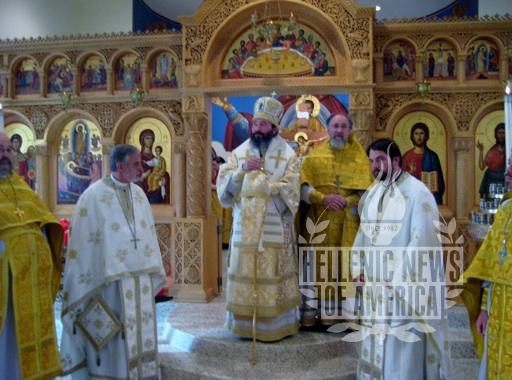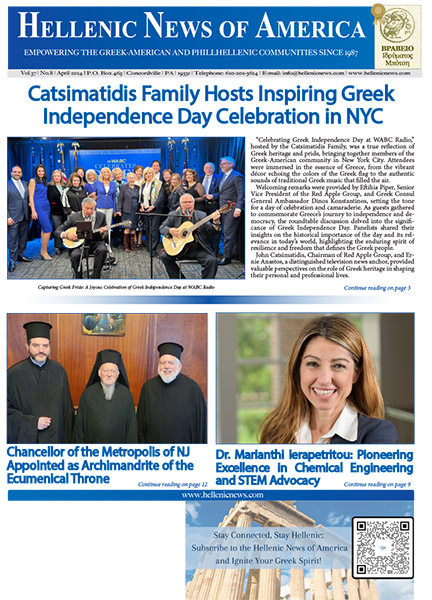
By Catherine Tsounis
The theme of Russian support for Greeks since the Fall of Constantinople in 1453 has been perpetuated in each generation. Russia played a major role in the creation of the Greek nation in 1832. Every generation is reminded in Modern Greek history and literature that Russia is their Orthodox brother who will always aid the Greek nation. This was seen in the escape of the Pontian Greeks into Russia Georgia during the Asia Minor catastrophe of 1922. Greek intellectuals and businessmen found a home in Russia during the 400 years of subjugation by the Ottoman Turkish Empire.
Russia’s historical relationship with Greece was seen at the historical visit of Archbishop Justinian, representative of the Moscow Patriarchate in the United States on Sunday, December 11th at the Kimisis tis Theotokou Greek Orthodox Church of the Hamptons. His Eminence was accompanied by the clergy and parishioners of the Russian church and St. Nicholas Patriarchal Cathedral choir in New York City. A traditional Slavonic liturgy was performed just “as in Russia”, according to Protopresbyter Rev. Alexander Karloutsos. The church’s account of the event with photos, videos and press release are at https://kimisishamptons.org/news-items/kimisis-parish-of-southampton-welcomes-archbishop-justinian-representative-of-moscow-patriarchate .
Mrs. Daisy Lainis, wife of WWII veteran Tom Lainis, described the Slavonic liturgy to me that day. Mrs. Lainis, educator and editor of the Kimisis tis Theotokou church newsletter, has volunteered her services in St. Nicholas Greek Orthodox Church, Flushing, St. John’s Church of Blue Point and Kimisis Church of Southampton. Her narration of our Byzantine roots in Western Anatolia inspired me to acquire a master of art’s degree of byzantine History in 1973 before the formation of a Greek Studies Center in the mid 1970’s. She told me once that the “Russia’s defeat in the Crimean War was a defeat for the Greeks because they were our allies. Western historians are biased towards Russia ho has helped the Greek Orthodox people.” Wikipedia confirms her view saying “Moreover, Greeks have always considered Orthodox Christian Russia as an ally and viewed the Crimean War as a grave injustice against Russia and any support of the Ottoman Empire a grave threat to Greece’s recent independence,” at https://en.wikipedia.org/wiki/Crimean_War. Her grandfather Kazanas perished in the 1922 death march of the men of Kato Panagia (in Tseme province of the State of Smyrna) into the interior of Asia Minor.
Listening to the Slavonic liturgy was a unique cultural experience. Greek was heard throughout the liturgy. “In peace let us pray” were repeated in Greek. Other Greek passages and words included: Kirie Eleison (Lord have mercy); Despota (His Grace); Agios o Theos (Holy God); Agios Athanatos (God is immortal); Eleision imas (Have Mercy on us), were repeated continuously. A person knowledgeable in Greek could follow the service. “I use to attend a Russian Orthodox Church in New York City,” said Mrs. Lainis. “During the service, a Russian priest gives confession openly in front of the congregation at the side of the church. The confessor does penance during the liturgy.” This is a practice that I have never seen before.
The St. Nicholas Patriarchal Cathedral choir‘s singing was unique. It was an Orthodox choir of voices such as Maria Callas and Luciano Pavarotti. The intense spiritual feeling of their singing comes from the experience of persons who have suffered to keep their religious faith. Deacon Rodiou Shamazov said “the conductor Ksenia Afanasyeva was trained in St. Petersburg. Her father is a conductor there.” The remarkable operatic performance was performed by the following persons: Ksenia Afanasyeva, conductor; Yana Eminova, soprano solo; Konstantin Stepanov, tenor solo; Zuran Ninua, Baritone solo; Oleg Klymentyev; basso solo; Janet Ayzen and Elena Granstrem, sopranos; Vladimir Voznyy and Nikolai Ohotin, tenors. Their singing reflects intensive training. When His Eminence was leaving the church receptuion, the choir began singing in different voice styles “Axios” (worthy), reminding me of an “Evening at the Met” on channel 13.
“The general cultural liberalization that followed Stalin’s death in 1953 brought a natural curiosity about the Russian past that especially caught the interest of younger generations,” according to Glenn E. Curtis, in the book Russia: A Country Study. “The ceremonies and art forms of the Russian Orthodox Church, an inseparable part of that past, attracted particular attention, to the dismay of the Khrushchev and Brezhnev regimes. Historian James Billington has pointed out that in that period religious belief was a form of generational rebellion by children against doctrinaire communist parents.”
Jennifer Friebely, secretary of the Kimisis Church parish council said she “was moved to tears a few times during the Archbishop’s service at our church. We were truly blessed to have him visit us. His choir filled the room with such beautiful music celebrating the liturgy…just incredible.” Anthony Moscato, a member of Kimisis Church, said he “thought the Slavonic service was fascinating. The choir was extraordinary, beautiful and angelic. I was originally Roman Catholic. I converted a year ago to Orthodoxy. My own near Palermo, Sicily was originally Orthodox until 1492, when Ferdinand forced all to abandon Orthodoxy.”
Many of us had the honor of having Holy Communion from His Eminence. Archbishop Justinian gave a moving speech in Russian that was translated into English by Father Alexander Golub, of St. Nicholas Russian Orthodox Cathedral of New York. “Today, we see a healing,” said the Archbishop. “A gathering apart from ethnic gatherings, bearing witness that we are all one in the Holy, Apostolic Orthodox Church. We glimpse our common heritage. We are all Americans, given the holy Orthodox faith. We embrace each other and say Brother. Our unity of different people makes us Christians. When Prince Vladimir of Kiev sent his envoys to Agia Sophia, they said ‘We no longer knew whether we were in heaven or on earth.’ St. Vladimir had our nation baptized in the Orthodox Church.”
The Archbishop, with eyes full of genuine pathos said “when Byzantium’s sufferings began, Russia helped the Mother Church. Ransom monies were paid to the Turks to save churches, Constantinople sent appeals for help. The Russian princes always helped. Then Antioch and finally Constantinople fell. The Orthodox Empire was left only in Russia with the last Orthodox Emperor on earth. Secular historians who do not believe in Christ will not understand Russia. We used our forces against the Turks believing the Cross will return to Constantinople. Many times we started wars with the Turks to save our Orthodox brothers. Love for our Orthodox brothers motivated our fights in the Balkans.” His Eminence looked as if he was carrying this tremendous loss on his shoulders.
Archbishop Justinian continued his emotionally charged speech by saying “the Greeks brought baptism to Russia and Russia brought Orthodoxy to Alaska. The Russian Church was the first to send bishops to the American continent, helping all.” An exhibition on “State & Church in Russian America” was made possible through the generous support of Messrs. Lloyd Cotsen and Plato Malozemoff, members of the James Madison Council of the Library of Congress. The exhibition states “the Russian discovery of Alaska and the Aleutian Islands by Vitus Bering (1681-1741) and Aleksiei Chirikov (d. 1748) in 1741 was inspired by Tsar Peter the Great (1672-1725). For half a century thereafter, adventurous frontiersmen and fur traders, the promyshlenniki, ranged from the Kurile Islands to southeastern Alaska, often exploiting Native seafaring skills to mine the rich supply of sea otter and seal pelts for the lucrative China trade.” The exhibition describes “one of these daring traders, Grigorii Shelekhov (1747-1795), encouraged by Tsarina Catherine the Great (1729-1796), established the first colony in Alaska, in 1784, at Three Saints Bay on Kodiak Island. Shelekhov’s colonial administrator, Alexandr Baranov, ruled so long (1790-1818) and effectively that he came to be known as “Lord” of Russian America. In 1794, the Tsarina fulfilled Shelekhov’s pleas to establish an Orthodox mission in Alaska, and in 1799, Tsar Paul I (1754-1801) awarded Shelekhov’s Russian American Company monopolistic control over trade and government, thus inextricably entwining the Company and the Church. The Company financed the Church in its missionary and educational work, while the Church became the custodian not only of the colony’s morals — often in opposition to Company practices — but also of the spiritual and intellectual nurturing of the Native Alaskans.”
“Although the initial confrontation of Russians and Alaskans was sometimes bloody, with the coming of the Orthodox priests relations generally became more harmonious and mutually beneficial. Before long, however, in 1867, Alaska was taken over by the Americans, for whom gold was, initially, a primary concern. Despite the radical changes wrought by Americans, the deep impression of Russia and Russian Orthodoxy remain to this day in Alaska.”
Archbishop Justinian continued this inspiring sermon saying “to the Arab Orthodox, we gave them Raphael (Archmandrite Raphael Hawaweeny who was studying in Russia) a Russian bishopric. I am grateful …..to all of you for having us perform the Russian liturgy in Slavonic. We pray freely in English. It is wonderful when traditions of the Mother Church are observed. Each flower blooms in its own color. Our national Orthodox churches must bloom with national traditions. Our dogma is the same. Do not be afraid. We are united in the holy canons. None of us will change the gospels or traditions. Our faith believes the Orthodox Church preserves all. We have not added anything or lost anything.”
Following the church service, the general community had the opportunity to talk with all. “I am very happy to be here with you,” Andrey V. Rogozin, Vice Consul of the Consulate General of the Russian Federation in New York. “Please feel free to contact us at the embassy anytime.” This is the new image of 21st century Russia.
Russia’s support of Hellenism has not been explored in depth in the English language. These materials are found in the Greek books sent from Greece for the Greek language schools. In the height of the Cold War, St. Demetrios of Astoria parochial school, in particular, educated their students that Russia would always support Hellenism and Orthodoxy. This viewpoint was supported in Greek-American homes, contrary to the view promoted in the Western press.
The strong Greek-Russian relations extend from ancient times with Greek settlements in the Black Sea coast. Old Church Slavonic or Church Slavonic is a literary language which developed from the language used by St Cyril and St Methodius, 9th century missionaries from Byzantium, to translate the bible and other religious works. Cyril and Methodius based their translations on a Slavonic dialect of the Thessaloniki area. The new alphabet appeared which was known as Cyrillic and named after St Cyril. The acceptance of Orthodoxy from Byzantium and the cultural exchange and influence tied the destiny of both nations. The Greek population, especially in Odessa during the 18th century, formed a dynamic part of Southern Russia.
The Filiki Eteria or Society of Friends was a secret 19th century organization, formed in Odessa, Russia in 1814. Its purpose was to overthrow Ottoman rule over Greece and to establish an independent Greek state. Society members were mainly young Phanariot Greeks from Russia and local chieftains from Greece. The Greek Revolution fought between 1821 through 1832 was successful because of the assistance of several European powers that included Russia. The Orthodox nation sent a navy to Greece that fought in the successful naval battle of Navarino. This success led to the creation of the Greek nation in 1832.
During the Greek civil war, many Greeks found refuge in Tashkent, Uzbekistan. They played an important part of the country’s life. In 1982 with the passing of the Amnesty law, they immigrated back to Greece and other countries. Mikis Theodorakis’ music was played all over Russia. The Mikis Theodorakis concerts were popular in the former Soviet Union.
In 2005, the St. Andrew Foundation of Russia awarded Mikis Theodorakis the St. Andrew Prize. Theodorakis is Greece’s most famous contemporary composer. The Russian cultural foundation awarded him the prize for his efforts to empower people spiritually and to promote peace and harmony between nations.
Parthena Neofytides, the sister of Astoria, New York Greek television producer Elias Neofytides, told us of her family fleeing the Greek Pontus. They sought refuge in Russia from the Turks in 1922. They were able to immigrate to the United States through the help of a Russian Orthodox priest. These are just many facts that prove the validity of Archbishop Justinian’s explanation of the closeness of the Greek and Russian nations.
Protopresbyter Alexander Karloutsos, Presbyter Constantine Lazerakis of the Kimisis tis Theotokou Church and Rev. Mark Arey performed a historical service that few have ever seen. To be alone and being the only Orthodox nation for four centuries is a heavy burden to carry. I experienced a day in Russia during the Christmas season at the Kimisis tis Theotokou Church in Southampton, New York.
Links:
https://en.wikipedia.org/wiki/Greek_War_of_Independence
https://countrystudies.us/russia/38.htm- the Russian Orthodox Church.
https://www.hecucenter.ru/eng/about.htm – Hellenic Cultural Center of Russia
https://www.omniglot.com/writing/ocslavonic.htm- Slavonic alphabet
https://www.helleniccomserve.com/forgottengreeksofuzbekistan.html- The Greeks of Uzbekistan.
https://www.akhistorycourse.org/articles/article.php?artID=201 – The Orthodox missionaries of Alaska
https://www.akhistorycourse.org/articles/article.php?artID=201 – Russian Orthodox Church in Alaska.
Photo 1- The Archbishop, with eyes full of genuine pathos said “when Byzantium’s sufferings began, Russia helped the Mother Church.”, as Rev. Alexander Karloutsos (left to right), Rev. Alexander Golub and Rev. Constantine Lazarakis listen.






